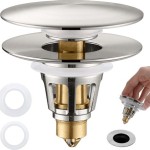Should a Bathroom Mirror Be Wider Than the Sink? Examining Design Principles and Practical Considerations
The question of whether a bathroom mirror should be wider than the sink is a recurring theme in bathroom design discussions. It touches upon aesthetics, functionality, and the overall sense of balance within the space. There is no single, universally correct answer, as the ideal mirror width often depends on the specific dimensions of the bathroom, the style of the vanity, and the personal preferences of the homeowner. However, by examining the underlying design principles and practical considerations, it is possible to determine the most appropriate mirror size for a given bathroom.
The bathroom mirror is more than just a reflective surface; it's a crucial element that impacts the perceived size and brightness of the room. A well-chosen mirror can visually expand a small space, amplify natural light, and contribute to a cohesive design scheme. Conversely, a poorly sized or positioned mirror can detract from the overall aesthetic and even hinder functionality. Therefore, careful consideration should be given to the mirror's dimensions in relation to the sink and the surrounding features.
While a mirror that is wider than the sink is often considered a visually appealing and practical choice, there are situations where a narrower mirror or a mirror of equal width might be more appropriate. To make an informed decision, it is essential to understand the advantages and disadvantages of each approach, as well as the factors that influence the optimal mirror size.
Aesthetic Harmony and Visual Balance
One of the primary reasons for opting for a wider mirror is to achieve a sense of aesthetic harmony and visual balance within the bathroom. In many cases, a mirror that extends beyond the edges of the sink creates a more unified and proportional look. This is particularly true when the sink is relatively narrow or when the vanity is part of a larger, more expansive unit. A wider mirror can help to visually ground the sink and prevent it from appearing too small or isolated.
The concept of visual balance is fundamental to interior design. It refers to the equilibrium of elements within a space, ensuring that no single feature overpowers the others. A wider mirror can contribute to this balance by creating a larger, more substantial visual anchor on the wall. This can be especially beneficial if the opposite wall features a prominent element, such as a large window or a decorative tile pattern. By creating a sense of visual weight on both sides of the room, the overall design becomes more cohesive and pleasing to the eye.
Furthermore, a wider mirror can enhance the visual impact of other design elements in the bathroom. For example, if the vanity features decorative hardware or an interesting countertop material, a wider mirror can reflect these details and draw attention to them. Similarly, if the bathroom has a unique lighting scheme, a wider mirror can amplify the light and create a more dramatic effect. By reflecting and enhancing these features, the mirror becomes an integral part of the overall design narrative.
However, achieving aesthetic harmony is not simply about choosing the widest possible mirror. The proportions of the mirror should be carefully considered in relation to the size of the wall, the height of the ceiling, and the overall style of the bathroom. In some cases, a mirror that is too wide can overwhelm the space and create a sense of imbalance. Therefore, it is essential to strike a balance between creating a visual anchor and maintaining a sense of proportion.
Enhanced Functionality and Practicality
Beyond aesthetics, a wider mirror can also offer significant practical benefits. The most obvious advantage is increased visibility. A wider mirror provides a broader field of view, making it easier to see oneself while performing tasks such as shaving, applying makeup, or styling hair. This is particularly important in households with multiple users, as a wider mirror allows more than one person to use the sink and mirror simultaneously without feeling crowded.
Moreover, a wider mirror can be particularly useful in bathrooms with limited natural light. By reflecting more of the available light, it can brighten the space and reduce the need for artificial lighting. This can not only save energy but also create a more pleasant and inviting atmosphere. In small bathrooms, the ability of a wider mirror to amplify light can make a significant difference in the perceived size and openness of the room.
Another practical consideration is the storage space around the sink. If the sink is flanked by cabinets or drawers, a wider mirror can help to visually connect these elements and create a more cohesive storage system. This is particularly beneficial if the bathroom is small and storage space is at a premium. By visually unifying the sink and storage areas, a wider mirror can help to maximize the functionality of the space.
The placement of lighting fixtures relative to the mirror is also an important factor. Ideally, lighting should be positioned on either side of the mirror to provide even illumination for the face. A wider mirror provides more flexibility in terms of lighting placement, allowing for a wider range of fixture styles and configurations. This can be particularly useful in older bathrooms where the electrical wiring may be less than ideal.
However, it is important to consider the potential drawbacks of a wider mirror in terms of functionality. For example, if the mirror is too wide, it may interfere with the operation of nearby doors or drawers. Similarly, if the mirror is positioned too close to a corner, it may create a blind spot or make it difficult to clean. Therefore, careful planning is essential to ensure that the wider mirror enhances rather than hinders the functionality of the bathroom.
Factors Influencing Mirror Size Selection
Several factors can influence the optimal size of a bathroom mirror, including the size of the bathroom, the style of the vanity, the height of the ceiling, and the lighting scheme. In a small bathroom, a wider mirror can be particularly effective at creating the illusion of more space. However, it is important to avoid choosing a mirror that is so large that it overwhelms the room. A good rule of thumb is to ensure that the mirror is no more than two-thirds the width of the vanity.
The style of the vanity also plays a significant role in determining the appropriate mirror size. A modern, minimalist vanity may pair well with a simple, rectangular mirror that extends slightly beyond the edges of the sink. A more traditional vanity, on the other hand, may benefit from a larger, more ornate mirror that serves as a focal point. The key is to choose a mirror that complements the style of the vanity and enhances its overall aesthetic appeal.
The height of the ceiling is another important consideration. In bathrooms with high ceilings, a taller mirror can help to visually ground the space and prevent it from feeling too elongated. Conversely, in bathrooms with low ceilings, a shorter mirror can help to create a sense of openness and prevent the room from feeling cramped. The height of the mirror should be proportional to the height of the ceiling to create a balanced and harmonious design.
The lighting scheme is also a critical factor. As mentioned earlier, lighting should be positioned on either side of the mirror to provide even illumination for the face. The width of the mirror should be sufficient to accommodate these lighting fixtures without appearing overcrowded. If the lighting fixtures are particularly large or ornate, a wider mirror may be necessary to provide adequate space.
Finally, personal preferences should always be taken into account. Ultimately, the choice of mirror size is a matter of individual taste and style. Some homeowners prefer a wider mirror for its aesthetic appeal and enhanced functionality, while others prefer a narrower mirror for its simplicity and understated elegance. The most important thing is to choose a mirror that reflects the homeowner's personal style and creates a bathroom that is both functional and visually appealing.
In summary, the decision of whether a bathroom mirror should be wider than the sink is a complex one that depends on a variety of factors, including aesthetics, functionality, and personal preferences. By carefully considering these factors and weighing the advantages and disadvantages of each approach, it is possible to choose a mirror size that is both practical and visually pleasing.

Can A Bathroom Mirror Be Wider Than The Vanity What To Keep In Mind Clever Homeowner

What S The Perfect Size Bathroom Mirror For Your Vanity Bathtubber

Should Bathroom Vanity Be Wider Than The Mirror

Should A Bathroom Mirror Be Wider Than The Vanity Aquarina

The Bathroom Mirrors Buyer S Guide Big

The Bathroom Mirrors Buyer S Guide Big

Bathroom Vanity Mirror Medleys Centsational Style

Can A Bathroom Mirror Be Wider Than Vanity Tona Com

Should A Bathroom Mirror Be Wider Than The Sink House Caravan

How To Choose A Bathroom Mirror Houzz
Related Posts







